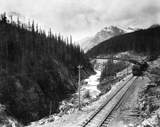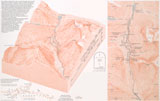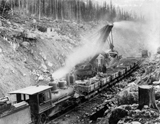The Passes Through the Canadian Rocky Mountains
Yellowhead (Leather) Pass
Kicking Horse Pass
Fleming’s route across the prairies and through the Yellowhead Pass was abandoned in favour of a more southerly and direct route, penetrating the Rockies by the previously unexamined Kicking Horse Pass. “In the early years of the twentieth century, the Canadian Northern Railway was built along the survey route advocated by Fleming.”1
When the Canadian Pacific Syndicate came to build the railway, the decision was made to carry the line across the prairies, far south of Fleming’s original surveyed route, and use the Kicking Horse Pass through the Rockies. This entailed heavy gradients which were lessened in 1909 by the building of two spiral tunnels.
The “Big Hill” (1884) and the Spiral Tunnels (1909) Through the Kicking Horse Canyon
The original surveyed line for the Kicking Horse Pass with a 2.2 percent grade was run from Wapta Lake to Otter Tail station across a number of avalanche paths and would have required a 1400 foot tunnel through the “nose” of Mount Stephen as well as passing about 300 feet above Field, B.C. Uncertainty about the terrain and the added time and cost to build this line necessitated an alternate route.2
The 4.1 mile “Big Hill” with a grade of 4.5 percent over 3 miles and 3.5 to 4 percent over the remaining distance was the temporary solution for carrying the line down the Kicking Horse Canyon between Hector and Field. Safety switches had to be installed in case a descending train went out of control and had to be diverted on to a catch siding.3
Increased traffic and the government requirement for a 2.2 percent grade made it necessary to find a permanent solution. The final route (another alternative was rejected) was designed by J.E. Schwitzer, Assistant Chief Engineer, Western Lines. The new plan included two spiral tunnels and lengthened the line to 8.2 miles while reducing the grade to the acceptable 2.2 percent.4
Crowsnest Pass
The first surveys for a railway through the Crowsnest Pass had been undertaken in 1892 on the north side of the Oldman River but nothing came of this project. The CPR selected a route on the south side of the river and location surveys began in April 1897 before the Act and the agreement were in place. Apart from the 300-foot deep valley of the Oldman River immediately west of Lethbridge, no major engineering difficulties were encountered.
The CPR decided to avoid this formidable obstacle and constructed a temporary line that descended to the valley floor, crossed the north-flowing St. Mary River at low-level and then climbed the west side of the valley to Nena and on to Macleod. The relatively soft, alluvial strata on the valley sides had been severely eroded and deep coulees had to be crossed by trestle bridges on the route to the valley floor. Twenty similar structures were necessary to take the track down the east side of the valley and 15 million board feet of raw timber was required for their construction.
The line was in operation to Crowsnest Pass, December 12, 1896. In order to exploit and protect its mining interests in south-east British Columbia, and forestall competition from the United States, mainly from the Great Northern Railroad, the Canadian Pacific built a railway from Lethbridge to Kootenay Landing in 1898 via the Crowsnest Pass.
piano_pc.wavNotes | Bibliography | Abbreviations
1. T.D. Regehr, “Sandford Fleming,” The Canadian Encyclopedia (Edmonton: Hurtig, 1988), p. 791.2. O. Lavallée, Van Horne’s Road (Toronto: Railfare Enterprises, 1974), p. 176.
3. Railway and Marine World, January 1911, p. 12. Note: Lavallée states 4.5 miles, p. 180.
4. Ibid., October 1909, p. 709; January 1911, p. 12.





